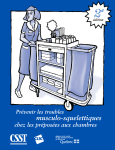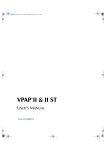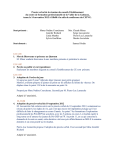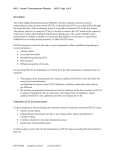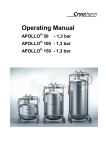Download About web-HUMAN
Transcript
About web-HUMAN
An overview with
direct links to how-to-do-it Help pages
(version 7.5a, Oct. 7, 2013)
Note well: The major ongoing revisions to this document are now complete.
I. Basic web-HUMAN
What is web-HUMAN?
Web-HUMAN is an integrative systems physiology teaching simulation that
presents educators and students
- with full web access to Tom Coleman’s classic physiology simulation
program HUMAN while
- delivering it via an interactive web interface that also provides the
user with many additional functional, learning and informational
enhancements.
a] The HUMAN simulation- what is it?- HUMAN itself was developed
originally as a research tool in the lab of Dr. Arthur Guyton at the University
of Mississippi under the direction of Dr. Tom Coleman. It was later
refashioned by Dr. Coleman into a teaching simulation.
b] web-HUMAN- what is it?- Web-HUMAN was developed for “inhouse” use as a physiology teaching tool at Skidmore College with the idea
of making the Coleman HUMAN model available to our students via an
internet browser of their choice- thus freeing the student and their
physiology courses from dependence on any particular hardware, software or
physical location.
By being out on the internet and thus open to all, it has become
increasingly used by a variety of courses at other colleges, universities and
physiologically oriented health professions programs. There, as at Skidmore,
web-HUMAN is employed in physiology simulation lab sessions, as a lecture/
demonstration tool and as a vehicle for student independent study.
How can I get started using web-HUMAN?
Try out the Introductory tutorial. This exercise takes beginners
step-by-step and screen-by-screen through each of the fundamental skills
needed to navigate your way through web-HUMAN.
The Introductory tutorial can be accessed
- from this tutorial link [ link ] and is also available
- on both the opening human page and in the User's Manual.
How do I run an experiment in web-HUMAN?
Simulated experiments are run by the same logical protocol used in
actual in-the-lab experiments. That is, one changes certain parameters in
the preparation and then observes the effects resulting from that change as
they develop through time.
a] To initiate a simulated experiment the user can change one or more
of the some 67 available variables via a mouse-click. Thus one might take
the model to high altitude by dropping the ambient barometric pressure.
b] To monitor the effects of the user-introduced change, the user
"mouses" their choice of output variables of their interest [from among some
140 output variables] and follows the changes in those variables through
time.
Thus one might choose to observe the respiratory response to the
altitude change by displaying the resulting arterial blood gas sample values
(PCO2, PO2, pH, HCO3-) as they change, minute by minute, through time.
A step by step example of such a high altitude experiment can be found via either of
the links below.
1-High Altitude: A sample one variable experiment investigating human response to a high
altitude (12,500 ft.) environment.[ PDF version ]
What type of simulated experiments can I run in web-HUMAN?
Simulated experiments can be done in a impressively wide variety of
subcategories including but not at all limited to the five sample areas listed
immediately below.
• Challenges to standard physiology- e.g. exercising the model at
different levels of intensity (O2 consumption) and monitoring the
resulting cardiac, respiratory, salt and water balance responses.
A step by step example of a such a challenge to standard physiology (an aerobic exercise
experiment) can be found via either of the following links.
2-Endurance Exercise: A sample multi-variable experiment investigating human response to a
simulated exercise bout. [ PDF version ]
• Comparative and environmental challenges – e.g. one might
move the model to high altitude (decreased barometric pressure) or
thermally challenge the model by moving it into a high or low
temperature environment and observe the related integrated
responses to the hypoxia or thermal challenge.
A step by step example of a such a comparative physiology experiment [ ascent to high
altitude ] is linked below.
1-High Altitude: A sample comparative/environmental physiology experiment investigating
human response to a high altitude (12,500 ft.) environment.[ PDF version ]
• Clinical challenges – e.g. one might create pathology* by
simulating the emphysematous aspects of COPD by decreasing
available lung surface area for gas exchange. Alternatively one could
simulate renal failure by removing a selected proportion of the renal
mass from the otherwise still functioning kidney.
Such a reduction in lung mean surface area available for gas exchange & its
developing consequences are illustrated step-by-step in the experiment linked below.
3-Emphysema: A sample induced clinical pathophysiology experiment investigating long term
response to loss of lung diffusion surface. [ PDF version ]
*Note that in addition to creating pathology HUMAN also has built-in clinical patients (see below section on Patients).
• artificial organs - Testing one’s understanding of the normal
physiology by attempting to run an artificial organ so as to maintain
normal levels of systems function. Web-HUMAN contains an artificial
heart, the ability to artificially ventilate, a kidney dialysis module, the
ability to infuse electrolytes, transfuse blood and more. *
An example of the use of artificial organ control in a teaching experiment can be found
in the respiratory physiology experiment employed at Skidmore College as linked below.
5- "Experimental Determination of Respiratory Dead Space" [ PDF version ]
• Testing one’s understanding of basic pharmacologic intervention
– the web-HUMAN Pharmacy contains a standard basic arsenal of
generic vasoactive, cardio active, renal and certain other select drugs.
It gives the user the ability to 1] administer pharmaceuticals, 2] adjust
their dosage levels and 3] select their frequency of administration.
An example of the administration of a pharmacologic agent, norepinephrine, can be
found in the web site's Teaching Tutorials Experiments section as linked below.
Norepinephrine Infusion Response (A pre-stored Teaching Tutorial Experiment) [ link ]
How is the physiological response monitored in web-HUMAN?
The response (change in the values of physiologic variables) to a
perturbation can be monitored by tracking the output response of variables
in both tabular and graphic in format.
Tabular Output - The default web-HUMAN output is a tabular readout
of the response of the physiologic variables vs. time. In any given
experimental run, users can select six from among over 137 user available
physiological variables to monitor in the main output table .
The rudiments of the user selection of variables for tabular output is covered in the
Introductory Tutorial cited at the beginning of this document. It can be accessed
- from this tutorial link [ link ] and is also available on web-HUMAN's opening page.
Graphic Output - We also provide the ability to graph the response
pattern of up to all six of the variables selected vs. time. The user can chose
between normalized (change from baseline value) or absolute value plot
formats and between one combined multiple variable plot vs. many single
variable plots.
The rudiments of the user selection of variables for both graphic and tabular output is covered
in the Introductory Tutorial cited at the beginning of this document. It can be accessed
- from this tutorial link [ link ] and is also available on web-HUMAN's opening page.
More advanced uses of the monitoring of the physiologic response
pattern of variables by both graphic and tabular methods can be found in
many of the Manual tutorials and examples.
e.g. A fundamental more advanced set of examples of the mechanics of the selection and
display of variables, both tabular and graphic, occurs embedded in the 3 screen by screen "How to do
it" experiment tutorials in the (User) Manual and are also linked right here [ link ].
Can I export data from a web-HUMAN simulated experiment to, for
example, graph the results in another application?
Yes, data can be exported. For example, the web-HUMAN Manual also
contains a section with instructions on how to pass data from web-HUMAN to
Excel for a fuller, custom graphic analysis.
Exporting data to Excel for graphing or further data massaging [ link ].
How many physiological systems does web-Human contain?
• HUMAN is a comprehensive systems level simulation that
incorporates many major sub-systems HUMAN is a (fairly) comprehensive model that incorporates the major
(systemic) responses of the cardiovascular, respiratory, renal, acidbase balance, thermoregulatory and fluid and electrolyte balance
physiological systems and, in addition, contains aspects of responses of the
nervous system, the hormone system and muscle/metabolic system.
• HUMAN is a integrative systems simulation Significantly these individual system responses are integrated. Thus a
high altitude challenge (reduced barometric pressure) shows not only the
expected hypoxia (low PO2) but also the accompanying hyperventilation, its
resultant hypocapnia (low PCO2) , the effect of this hypocapnia on blood
acid-base status (a respiratory alkalosis) and the compensation over time
via the kidneys (compensatory metabolic acidosis). The effects of this
challenge and the response to it by other systems (e.g. the cardiovascular
system) are also apparent.
How can I access and manipulate the built-in Clinical Patients in
HUMAN?
Web-HUMAN has built into it a separate section of simulated Clinical
Patients.
• User support- These Patients can be examined/studied with (or
without) the aid of various levels of Hints in order to arrive at an Analysis/
Diagnosis.
• Range of cases- These clinical 'cases' include heart failure, various
types of renal disease, congenital central vascular shunts and more.
• How to access & examine Patients
The [User] Manual's Help screen links below detail
1] the basics of how to access these clinical cases
* Patients Help 1 - The basics: How to access .. [ link ]
2] and how to utilize the more advanced Hints & Analysis/Diagnosis
sections that are available in the main Human Clinical Patients table.
* Patients Help 2 - Hints, Analysis/Diagnosis [ link ]
Also note that many other clinical cases are available in the Save & Retrieve and the One-click sections of HUMAN
II. More advanced web-HUMAN - Select additional features
A. Select additional features - On Line Help
In addition to off-line Help such as this document, web-HUMAN offers
Help on-line [i.e. within the model itself as you are running your simulation].
This Help is of two types. 1] Help on variables - offers extensive crosslinked information on all HUMAN variables 2] Help on how-to-do-it - do wish
to take a blood gas sample, administer an infusion, a transfusion, induce
pathology, etc. ? The how-to-do-it Help screens give you access to
instructions on each of these an quite a few more.
A set of tutorial help pages [from the Manual] on how to access and use On Line Help is linked
right here [ On-line Help ( link ) ]
B. Select additional features - Save & Retrieve
Web-HUMAN allows registered users to save & retrieve their
simulations (and those of other users). This less used but rather powerful
ability to Save/Retrieve simulations adds multiple additional possibilities for
users
• Model storage- Most obviously, users can store their current
simulation to be called back at any later time for additional examination or
continuation.
• Sharing models- They can make their simulation available to others
[e.g. fellow students, instructors] (at their choice).
• Folder creation- One can create a named Folder
[e.g. RSM_HighAltitudeExperiments] into which one's experiments are then
stored.
The above save/retrieve capabilities create many new possibilities.
• e.g. Possibilities for course use- Instructors can create their own
institution’s folder space within HUMAN. This enables much easier
pedagogical use of HUMAN by a group of individuals and and also allows for
student collaborative simulation work.
• e.g. Availability of a growing fund of pre-stored one-step, click and
run experiments- these allow instructors and their students to utilize
HUMAN without any prior knowledge of how to set the model up.
• e.g. Availability of a wide range of new sample simulations- these
include 1] new custom-created clinical cases ('Patients') 2] sample
experiments and tutorials and much more.
Help pages on how to utilize the Save and Retrieve capabilities are available via the following
link. [ Save/Get Help link ]
C. Select additional features of web-HUMAN - User Manual
Web-HUMAN contains quite a few additional capabilities not detailed
above. These, (and some of the material above,) are all available in the User Manual.
All simulation pages contain a link to this User Manual on the upper
right of the page being viewed (i.e. Manual). In the Manual users will find
many “How to do it” tutorials (including the ones linked above), an extensive
analysis of the capabilities of web-HUMAN in the "Annotated List of webHUMAN variables and parameters" and much more.
One can access the Manual via its link on each simulation page and also via the following link.
[ User Manual ( link ) ]
In addition examples of teaching labs are provided, including all of
the original ones from Drs. Randall and Coleman's HUMAN 81 plus ones
employed at Skidmore and other institutions. In addition, quite a few other
sample simulations are available here.
Links are available to material used in past web-HUMAN workshops,
more information can be found about the underlying model itself, its author
(Dr. Coleman), the co-author of the microcomputer version (Dr. Randall) and
much more.
Bottom line: Anytime you have a question or need more detailed
knowledge on some aspect of using the model you have two resources
available.
1] off-line- Click on the User Manual link at the page top-right
2] on-line- Click on 1 of the 2 on-line Help links on your simulation
page.
A word of caution in using HUMAN – HUMAN is a teaching tool
Models cannot contain more than is built into them!* We essentially
present, via a web interface, Dr. Tom Coleman's HUMAN physiological model
albeit with many enhancements. This simulation was written by Dr. Coleman
at a time when the shape of the major behaviors of these particular
physiological systems was known experimentally and the interactions
between these physiological systems had been characterized. Since this is
almost exactly the fundamental physiology that most of us engage in
teaching our students, this makes HUMAN a potentially powerful teaching
tool.
* although they can certainly can yield unanticipated new interactions between systems and be used to
test as yet unexplored hypotheses.
On the other hand, this implies certain limitations. One should not
expect web-HUMAN to contain the newer concepts of a more subtle
regulatory interplay between system or, for that matter, newer
pharmaceuticals developed to address mechanisms discovered after HUMAN
itself was written nor the behavior of additional systems not modeled in
HUMAN itself.
Those using the web-site to teach fundamental physiology, at the preprofessional, college or graduate level, will likely find these limitations of
model to be of little or no concern to them since their focus is likely to be
fundamental physiology. They should nevertheless keep these limits in mind
as necessary.
Contact us if we can be of help!
Use of web-HUMAN by the physiology education community has been
growing steadily with approximately 100,000 plus non-Skidmore simulation
sessions run within the past year. If you have any questions we can help
you with or have any suggestions for features you would like to see, please
write to me ([email protected]) or to Leo Geoffrion
([email protected]) and we will certainly try to get back to you as soon as is
feasible within the framework of our schedules.
Enjoy!








